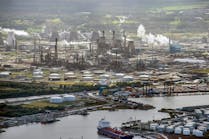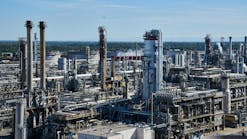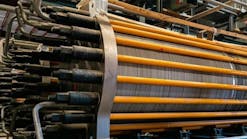Bob Tippee
Managing Editor-Economics and Exploration
Future expansion of crude oil production capacity in the Middle East is anything but certain-at least with crude prices at recent levels.
There is little doubt that the world will need more production capacity than now exists unless petroleum consumption sags. And there is even less doubt about where prospects are best for production capacity growth.
Future capacity expansion will occur mainly within the Organization of Petroleum Exporting Countries. And most OPEC expansion will occur in the Middle East.
Elsewhere, production capacity will come and go. Capacity in the former Soviet Union, for example, has room to grow significantly. Capacity in the U.S. does not, at least under the current regime for federal leasing. While there will be large discoveries and associated development projects around the non-OPEC world, which will add to production capacity, they will tend to be offset by natural declines in mature producing regions.
These net changes in non-OPEC production capacity are certainly important and raise questions about how much new production capacity OPEC will have to develop. But only OPEC countries have room for production capacity growth sufficient to deal with all anticipated increases in petroleum demand.
OPEC, especially Middle East OPEC, is where the monster reserves are; moreover, it is where the monster underdeveloped reserves are.
OPEC members in the Middle East account for 65% of the world's reserves. But they don't produce from those reserves at nearly the rate that the rest of the world does.
Reserves lives-which measure extent of development-in the OPEC Middle East amount to 110 years at current production rates but only 22 years everywhere else. It is in areas of high reserves and high reserves lives that production capacity has the greatest room to grow.
The problem is that high levels of reserves require only fortuitous geologic history and successful exploration; production capacity requires money.
And that adds a tricky question to uncertainty over how much new capacity will be needed in the OPEC Middle East: Will sufficient capital be available when it's needed in a region of unsettled politics?
SURPLUS NORMAL
These questions are important because production capacity is the essential upstream ingredient in petroleum supply.
Indeed, the market seems to require that a surplus of production capacity exist to cover unexpected surges in consumption.
In the decade following the Arab oil embargo of 1973-74, a hypothesis developed that said OPEC could raise the crude price when worldwide demand as a share of total production capacity exceeded 80%. It proved about as valuable as most rules of thumb.
The world changed. Consuming nations developed strategic inventories and conservation strategies. OPEC-at least most of it-learned that rising prices invite competition and squelch demand.
Raising prices no longer can be assumed to be the group's preeminent motive.
Market mechanics changed, too, with the development of forward trading contracts, options, and computerized trading. Products markets now are more visibly connected with their crude oil counterparts than they were just a few years ago. Supply and demand signals zing through all markets more clearly and quickly than ever before.
A given expansion or contraction in the production capacity surplus, then, might or might not affect the price of crude much; it depends heavily on conditions in product markets at the time of the change as well as whatever extraordinary factors may be at work. Just such an extraordinary factor is at work now: the international embargo on oil exports from Iraq.
At least for now, the crude market seems able to function without panic atop a smaller cushion of surplus capacity than it seemed to require in the 1970s and early 1980s (Table 1).
The market needs a surplus, nevertheless.
And it has come through a thin spell as historic surpluses go, leaving significant spare capacity in a relatively few hands.
The Centre for Global Energy Studies (CGES) noted in its Monthly Oil Report for May that OPEC's available production capacity surplus is concentrated in four countries, three of them in the Middle East. Those countries are Saudi Arabia, Kuwait, the United Arab Emirates, and Venezuela (Table 2).
Other OPEC producers, it said-including Iran, Nigeria, and Libya-are having trouble maintaining surplus capacity because of financial and political problems. And several will have less sustainable production capacity at yearend than they had at the end of 1993.
"As a result," CGES said, "the total spare capacity available to OPEC producers excluding Saudi Arabia, Kuwait, Venezuela, and the U.A.E. is probably less than 600,000 b/d."
DEMAND GROWING
Worldwide demand, meanwhile, has surpassed expectations so far this year.
And those expectations were already pointing to the need for additions to crude oil production capacity.
Late last year, the International Energy Agency projected oil consumption growth of 40% between 1990 and 2010 to nearly 4.1 billion metric tons/year.
And it said demand for OPEC oil during that period would nearly double, with most of the increase coming from the Middle East and Venezuela.
In the IEA projection, all net oil supply growth through 2010 occurs in the Middle East and Venezuela, with offsetting gains and declines elsewhere keeping supply from the rest of the world essentially unchanged.
That requires significant capacity increases in the Middle East and Venezuela.
And the tendency has been to assume that the capacity will materialize as needed.
OPEC, however, has been declaring for years that it needs help from the consuming world in the form of investment or demand guarantees to assure orderly expansion of production capacity.
More recently, analysts have begun to look at how the uncertainties surrounding capacity expansions likely will affect the necessary investment.
Cyrus H. Tahmassebi, Ashland Oil Inc. chief economist and director of market research, focuses on two of those uncertainties-one conventional and the other one less so.
The conventional uncertainty concerns how much new production capacity will be needed. Tahmassebi concentrates on the call on oil from OPEC, which except for Venezuela, as the IEA analysis shows, increasingly means Middle East OPEC.
The call, Tahmassebi points out, depends on two variables that are difficult to predict and thus create great uncertainty: future world oil demand and the level of non-OPEC supply.
In 1995, the variables yield a range of uncertainty in the call on OPEC oil of just 1 million b/d. By 2010, however, the difference grows to about 11 million b/d.
"This is obviously the crust of the matter because such a huge uncertainty could have many undesirable consequences," Tahmassebi told an IEA meeting of energy analysts in Paris last November.
"By and large, the bigger the level of this uncertainty, the greater the probability for OPEC's inability to generate sufficient capacity to meet the call on its supply in a timely fashion."
REVENUE QUESTIONS
Since that meeting, Tahmassebi has elaborated the less-conventional question about financial conditions, and therefore political stability, within OPEC members themselves.
Political stability in the main producing countries is one of several conditions that the Ashland economist considers essential to development of supply sufficient to meet anticipated demand with crude prices at recent levels.
The other conditions:
- Declines in non-OPEC production or continued increases in OPEC market share are tolerated politically and economically.
- OPEC countries revert to reintegration and/or are provided with generous financing facilities.
- OPEC countries control their population growth and launch economic stabilization-meaning austerity-and diversification plans.
- Environmental, political, and economic uncertainties are held to minimums.
- The allocation of economic rent is not altered significantly.
In a February presentation at Johns Hopkins University, Tahmassebi called the probability that all or most of these provisions will come true "very small."
Central to his argument is a close look at per-capita oil revenues in OPEC countries, which have plummeted since the early 1980s (Fig. 1).
The outlook is for less than robust per-capita oil revenue growth through 2010, even if oil prices, adjusted for inflation, hold at $20/bbl (Tables 4-5).
Populations are growing in most OPEC countries. Growth rates at just 75% of those recorded in 1980-91, for example, would take Iran's population to 69.2 million in 2000 and 87.9 million in 2000 from 55.8 million in 1991, Kuwait's to 2.7 million in 2000 and 3.7 million in 2010 from 2.1 million in 1991, and Saudi Arabia's to 19.4 million in 2000 and 26.4 million in 2010 from 14.7 million in 1991.
The population and per-capita revenue trends will create political tensions that, combined with the uncertainty over the call on OPEC oil, will make progress toward required capacity levels anything but smooth (Table 6).
Tahmassebi expects that OPEC will be unable or unwilling to generate sufficient capacity in a timely fashion, that political instability will plague at least some of the major producing countries, and that regional conflicts will escalate during the forecast period.
The results, he says: market volatility and "possibly much higher prices" after 2000.
What is certain, then, is that the world will need new oil production capacity from OPEC, and that with the exception of Venezuela most of that new capacity will have to be developed in the Middle East. It is also likely that reserves in the region can support all levels of expansion seen at present to be necessary for at least the next decade and a half.
But uncertainties like those cited by Tahmassebi make planning for the required investments difficult at best.
Economic theory sans that, as long as reserves are sufficient, the world will have the oil production capacity that it needs. Economic theory, however, does not guarantee that it will happen with crude prices at $20/bbl and less.
Copyright 1994 Oil & Gas Journal. All Rights Reserved.


